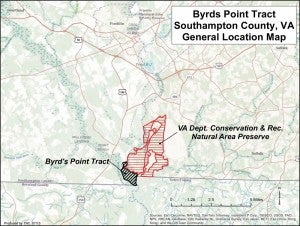Byrd’s Point added to nature conservatory
Published 1:28 pm Tuesday, July 30, 2013

The wetlands along Byrd’s Point, a newly designated conservation site dedicated by The Nature Conservancy. The site is along the North Carolina and Virginia border where the Blackwater and Nottoway rivers meet to form the Chowan River. — Submitted
FRANKLIN—Boaters, birders and others interested in wildlife conservation can look forward to a 443-acre tract of land no longer being open to commercial, logging or residential development.
Byrd’s Point, as it’s called, is named after William Byrd, who surveyed the area in 1728. The land is at the confluence of the Blackwater and Nottoway rivers near the border with North Carolina and forms the Chowan River. The property helps link more than 20,000 acres of conservation lands in Virginia and into North Carolina.
“The scenic value is one of the big public benefits,” said Brian van Eerden, director of the Southern Rivers Program for The Nature Conservancy. “It contributes to the efforts to maintain the beauty of the Blackwater River, and the Nottoway, of course, is equally as impressive.”
The area is also not far from the new Hercules Boat Launch by the Highway 258 Bridge, so boaters have easy access to it, said Riverkeeper Jeff Turner.
“It would be a great place for people to canoe, kayak or just put-put by there and look at the wildlife,” Turner said. “It is great that it won’t be logged or anything. It will be there in its natural state.”
This area will join some 4,000 acres being preserved on waterways in Virginia, much of it along the Blackwater and Nottoway. Turner said some parts of the river have already been logged, and it is an eyesore, and also a habitat killer.
Wildlife habitat conservation is another big part of it, van Eerden said. Most important is habitat for the river herring and longleaf pine.
“The river herring is a part of this area’s cultural history, and the herring have dropped considerably in numbers,” he said. “At some point, the herring will come back, we think, and what we are doing is making sure as their stock increases that there will be premier habitat when they make their migratory runs up river.”
Turner asked that people imagine what happens when logging crews come through and destroy habitat.
“When they go in and clear cut the swamp and don’t leave anything there, think of where all that wildlife has to move,” he said. “I don’t even know where they all go.”
The longleaf pine is a big part of how The Nature Conservancy received its grant from the Commonwealth of Virginia. The South Quay Sandhills Natural Preserve area, which Byrd’s Point now belongs to, has some of the best remaining examples of longleaf pine forest, van Eerden said.
“At one time, longleaf pine forests occupied more than 1 million acres in Virginia,” he said. “Now it is down to a couple hundred acres, and the best chunk is in this area. It has been a priority for the state and The Nature Conservancy for decades.”
The area is also important historically, not only for an area where surveyors came through and camped, but it also has links to the revolutionary and civil wars.
“During the Revolutionary War, the community of South Quay was on the Blackwater River,” van Eerden said. “It was an important inland port that had a big shipbuilding area, and until it was burned during the war it was a major port.”
Along the river as well, there are some land features that point to the entrenchments that were put in place by both the Union and Confederate armies during the Civil War, as the river system was important for both sides to control.
In more modern times, the area was important for river barge traffic feeding to the former Union Camp Saw Mill.
“If that property could talk, and tell what it had seen, it would point to a lot of interesting historical events in the Western Tidewater area,” van Eerden said.
Turner was a big part of making this happen, he added.
“He is an inspiration for doing water conservation,” van Eerden said. “He has a true vision and passion for doing water conservation.
“In practical terms, he has been a huge boost in providing river tours for funders and donors, to show first hand how important the area really is.”
Turner likewise thanked van Eerden for having such a big interest in the two rivers.
“We are very lucky to have him,” Turner said.
For landowners thinking of selling timber rights, van Eerden suggested that conservation was a good route.
“Landowners who would like to see wetlands conserved, but still get some cash out of their timber, should consider The Nature Conservancy,” he said. “Not only do landowners get money out of their timber, but it is a win-win for us because it provides protection for important wetland areas.”
Another funding source was through a grant through the U.S. Fish and Wildlife Service. The Nature Conservancy is a non-profit private organization that has been active in Virginia for more than 50 years.
Sheriff Jack Stutts, who owns land near the property, said he was excited to see the area conserved as a citizen of Southampton County.
“I just think it is wonderful that they got it,” Stutts said. “It is nice to know that it is going to stay just like it is, and be there for everyone to enjoy.”






